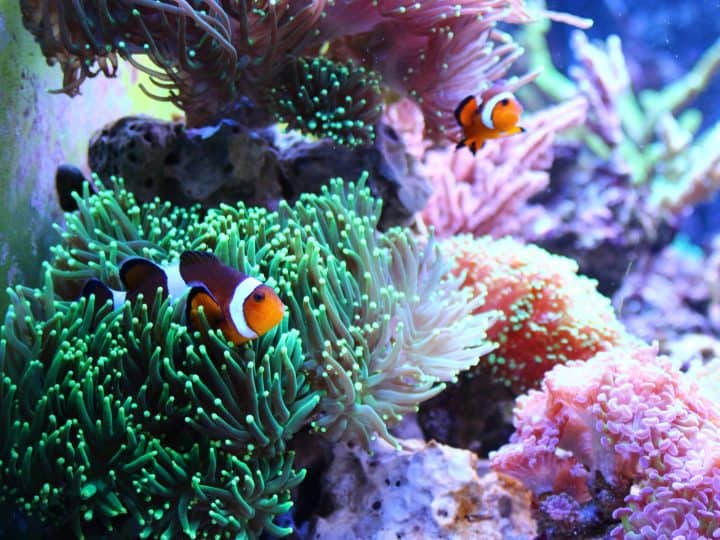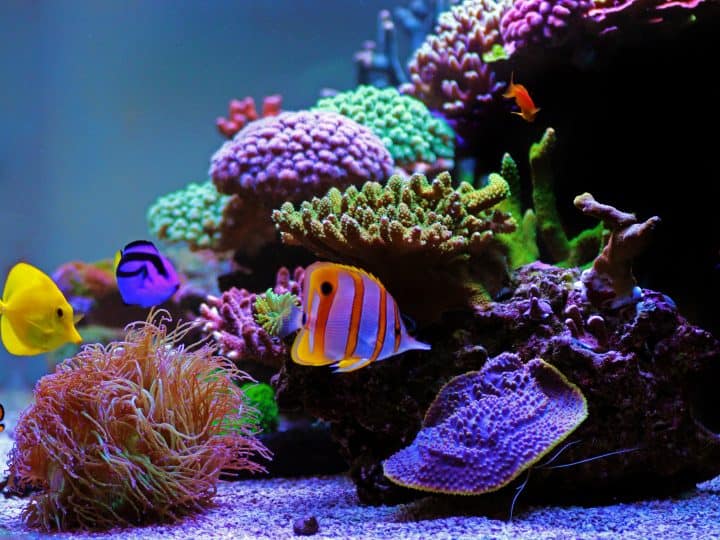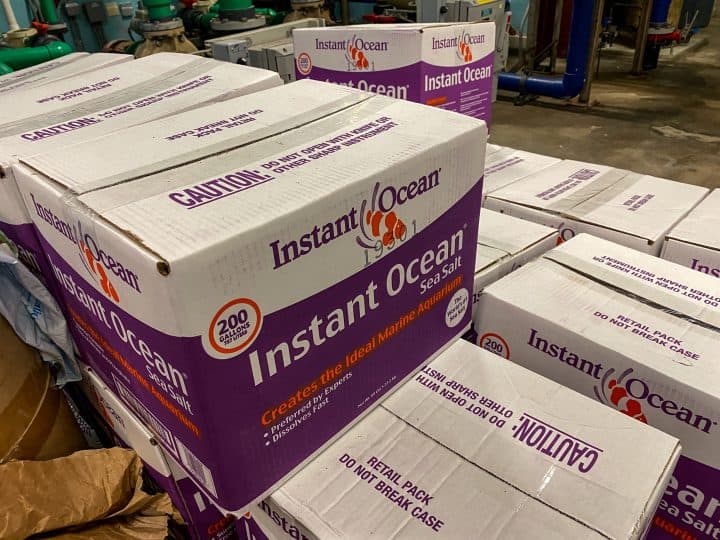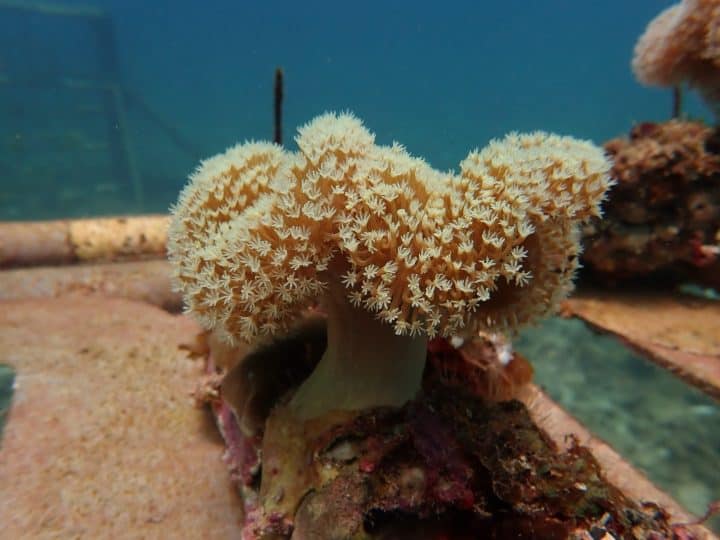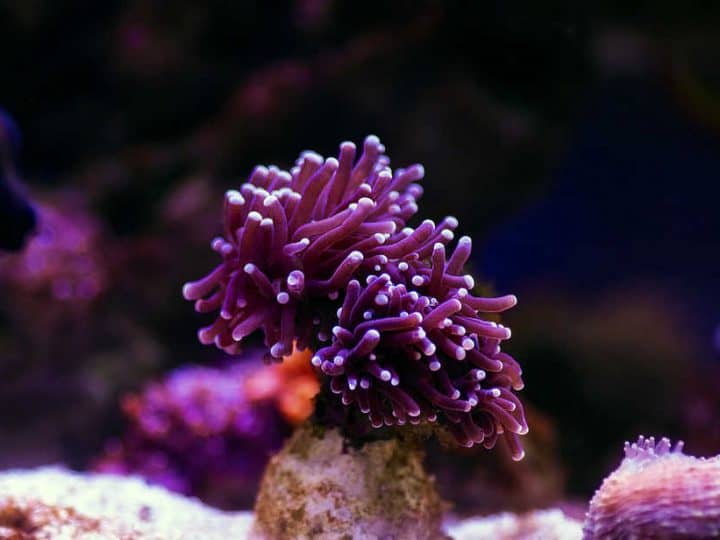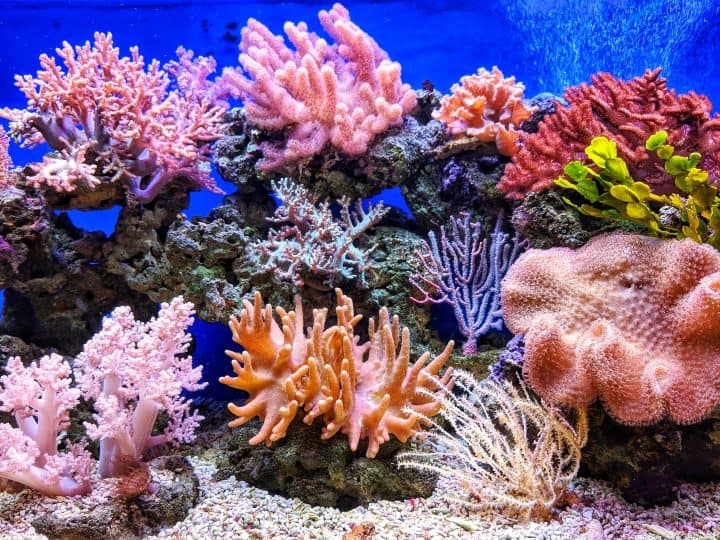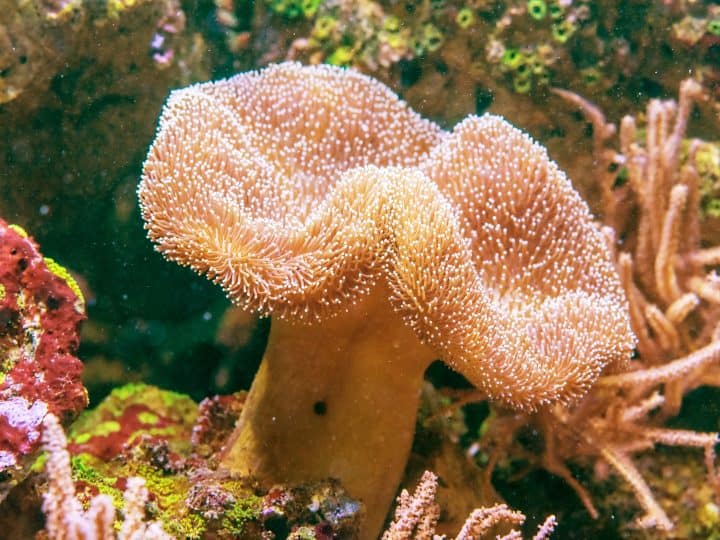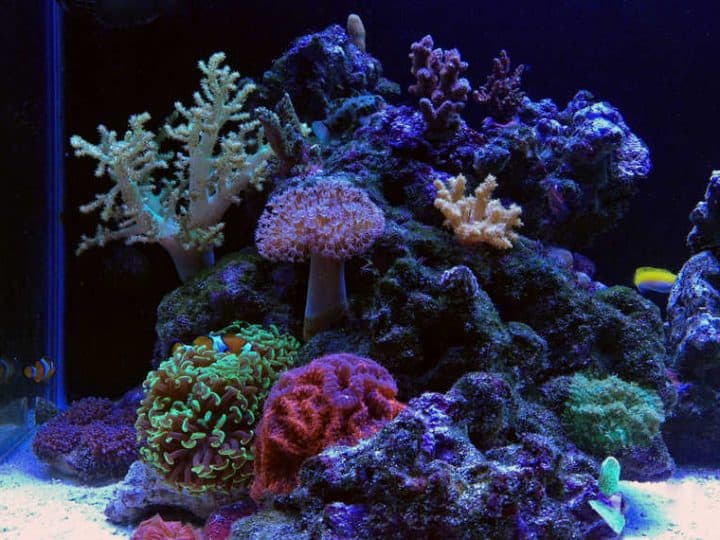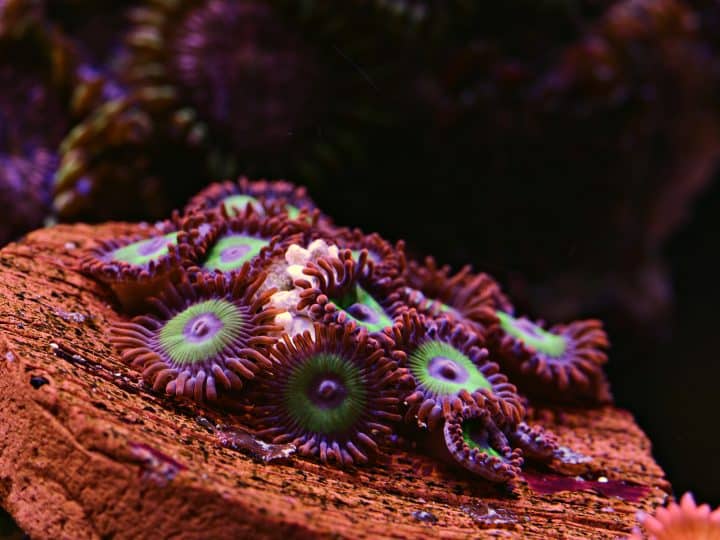Lava rock: You can ask about it and crawl through forums talking about it, but a thorough article like this one is the only thing you need. This guide comprises all the details regarding lava rock in an easy-to-digest form. You can benefit if you own a saltwater aquarium.
Quick Answer
Natural lava rock is safe for your aquarium. However, the market is flooded with artificial lava rocks that contain toxic chemicals. You should either pick lava rock carefully or choose alternatives. For example, base or living rock. They rarely contain poisonous substances such as heavy metals.
You may have doubts related to lava rock — that’s your right, but don’t jump to conclusions yet. If you want to find the answers once and for all, read on to discover the benefits of adding lava rock, common problems that may occur, and ultimately, lava rock tips.
Should You Add Lava Rock to a Saltwater Aquarium?
Numerous aquarium enthusiasts are unaware of the many hidden advantages of lava rock created by the high heat of volcanoes. Lava rock can genuinely make your aquarium maintenance much easier. Natural lava rocks contain helpful denitrifying bacteria; it is excellent for creating the optimum living environment for your tank. By replicating and then eliminating nitrates, these bacteria will enhance the quality of your water.
What is Lava Rock, and Why Does It Matter?
Lava rock is a stone that formed once lava erupted from a volcano. Like sedimentary rocks, volcanic rocks are assembled by shaping rather than by substance creation.
The dark Hawaiian sand, for example, is separated basalt rock (which makes up about 90% of every volcanic stone). Indeed, even inside the single stone sort of basalt, science can be exceptionally factor dependent on the magma body it came from.
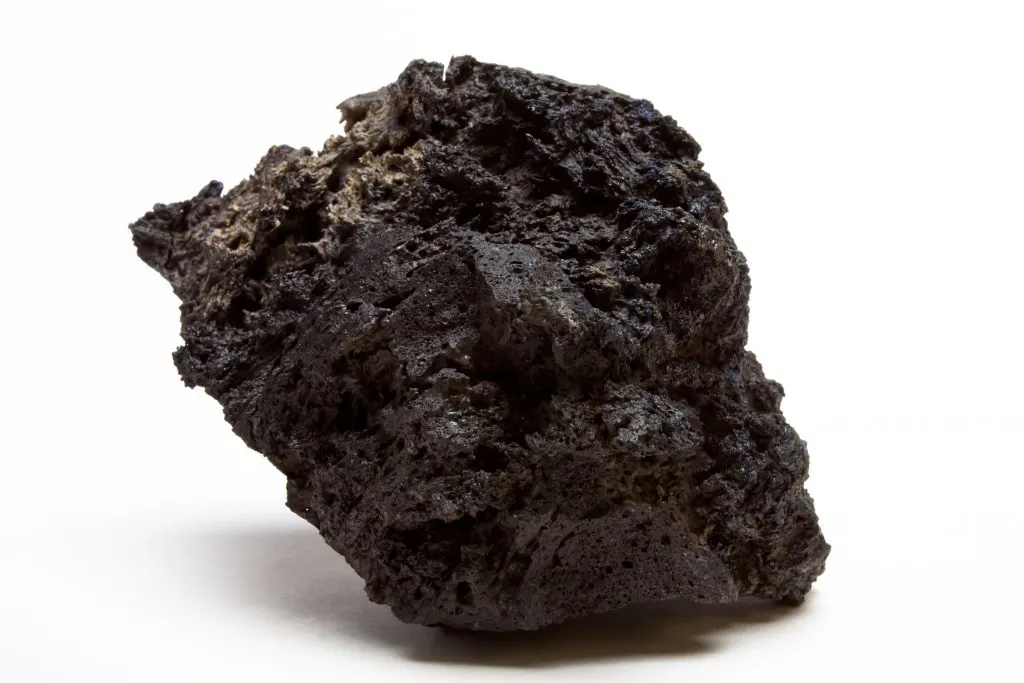
Basalt can take numerous textural and morphological structures. Vesicular basalt would be best for aquarium applications as there are many tiny openings in from air bubbles, giving it an enormous surface region. I want to note that scroria (otherwise called soot), a profoundly vesicular volcanic stone, is regularly called “lake rock” and is utilized in freshwater lakes because of the excellent surface region it gives.
I see no topographical or compound explanation that vesicular volcanic rocks can not be utilized in marine applications. I would fix any dry stone for a couple of months to leave any dissolvable toxins alone pulled out. You could generally run a pack of carbon with the relieving rock in case heavy metals bother you.
Natural Lava Rock vs. Artificial Lava Rock
Natural lava rock is highly resistant to saltwater. Due to the porous nature of the stone, volcanic rock may dissolve silica into the water. If silica is essential to your tank, consider adding natural lava rocks.
Live rock is a host to the numerous marine organic entities that live on and inside it. Live rock is normally made out of calcium carbonate. Yet, it very well may be made of a wide range of materials, including manufactured substances, concrete, and surprisingly the aragonite skeletons of antiquated stony corals. Live rock establishes typical coral reefs: from the deep oceans to the very aquariums in your and my house.
Live rock is an excellent natural filter for any aquarium. Aquariums are closed structures; all food placed in the aquarium for your fish and other residents must exit the tank somehow. Live rocks help to process wastes, sorting and removing the food from the tank. Organic filtration is essential for the health and longevity of your aquarium’s inhabitants. You might be wondering how a stone can accomplish that; I’ve never seen one move, let alone clean my tank. The most popular method of separating food from section to depart makes a few steps necessary for the continuous nitrogen cycle within your aquarium. Natural lava rock does the same; on the flip, artificial lava rocks may cause problems with heavy metals within your tank. I don’t recommend using any artificial lava rock.
Benefits of Adding Lava Rock
The following are a few advantages of adding volcanic rock to your aquarium.
Brings down Nitrate Levels
Assuming you need the plants and fish in your aquarium to live in a stable climate, lava rocks are an extraordinary way to accomplish that. Lava rocks have openings and pores that have valuable microbes, which are called denitrifying microscopic organisms. These microorganisms can help in keeping typical nitrogen cycles in your aquarium. Tiny organisms frame oxygen and nitrogen to assist your fish with growing in a cleaner environment.
Gives Caves
If you have little fish, you are probably aware of how much they enjoy caves. They utilize them as resting spots; therefore, having some in your fish tank is a good idea. Because basalt is highly porous, you can use it to create caves for your fish. These stones are so light; you won’t have to worry about them shattering your aquarium glass.
Massive rocks are unexpectedly superior since they just provide more cavern options. The most excellent thing about lava rock being used as caves is that the form or hue of the caverns does not alter when anything frames them.
Holds Plants
Other than fish, plants and corals are likewise found in your aquarium. Basalt will assist you with grounding your plants so they can give clean air to your fish. You can utilize basalt to secure your plants. Another function rocks can perform fencing. For example, you can protect passive corals against more aggressive species. Lava rock can physically block tentacles of dominant corals.
Guarantees Better Water Clarity
If you’re struggling with poor water quality, lava rock may help. The best feature about volcano rocks is that they clean water naturally, keeping the elements such as nitrates and phosphates in balance. It’s ideal for giving the perfect living climate to your aquarium since it has advantageous denitrifying microbes. These microbes will further develop your water quality by repeating and afterward eliminating nitrates.
Many aquarists are unaware of another hidden benefit of lava rock: an anaerobic environment is created within the stone as beneficial nitrifying bacteria consume all of the oxygen in the water. Denitrifying bacteria burn down the nitrate and generate oxygen and nitrogen inside the stone’s anaerobic environment. Because nitrate in the aquarium is bad for fish and shrimp, Lava Rock becomes an even more helpful way to eliminate nitrate.
The combination of lava rock and shrimps is an even more effective cleaning process that occurs naturally—shrimps like scrounging on lava rock for bits of food that may have fallen into the openings. Shrimp also want a safe place to shroud when they shed, so building a tunnel out of tiny pieces would be ideal for them.
Common Problems Might Occur Using Lava Rock
Here are some hints to remember before purchasing lava rock for your aquarium:
- Avoid lava rocks with sharp edges as they might harm your plants, fish, and corals. You can rub edgy rocks against each other to smooth them out. The size of the stone doesn’t make any difference—yet the shape does. Try to avoid rocks with pointed edges.
- Purchase the rocks with less density. The more pores it has — the better. Picking rocks with less density will help you save time and water when you’re cleaning your aquarium. Otherwise, you may face long cleaning sessions.
- Rocks with high density can leave grime and trash at the lower part of your aquarium, which will just draw out your cleaning cycle. So, lava rocks with less density can save you a great deal of water and time over the long haul.
How to Prepare Lava Rock for Safe Aquarium Use?
If you’re planning to use lava rock, you can follow this short guide to make it right, harming no aquarium habitats.
Wash the Lava Rocks
Take your lava rock and put it in the unfilled container. Fill the container with water till there is no space, and clean the stones with the brush. After a short time, your water will change tone due to the igneous rock. No compelling reason to freeze, however – this lone implies that your stones are getting cleaner.
Simply dump the shaded water and get a new container. Essentially rehash it till the water changes tone once more. You can even rub two basalts against each other to effortlessly dispose of any sharp edges that might be destructive to your fish. The subsequent stage includes drying your volcanic rock. Simply leave them under the sun for a couple of hours.
Boil the Lava Rocks
Boiling rocks can help you eliminate any harmful bacteria that may have become onto your rock. Be exceedingly cautious when heating your stones since igneous rock can detonate if bubbled for an extended period at high temperatures.
Boiling also helps remove any mud and grime from your stones — so they don’t transmit any illnesses that might harm the plants, corals, or fish in your aquarium. You may easily clean the rock by bubbling it, as boiling rocks is perhaps the most effective way to sterilize rock.
Ensure that you fill the pot with water and submerge the stones completely. Likewise, ensure that your boiling pot has a lid to ensure your safety. You can choose a large saucepan to heat your stones in. Don’t leave them to boil for more than 30 minutes. If you continue to bubble them for an extended time, your volcanic rock may crumble or shatter.
After you’ve done boiling the basalt, don’t put it in the tank right away. To begin, use a towel or a soft fabric to wipe out all of the water. Then let it chill for at least an hour.
Utilize a Bleaching Solution
Blanching your basalt isn’t as effective as bubbling it, but you may use it if you’re confident that your pumice won’t crumble or shatter. This method is more practical if your stones are large and bubbling them will not cause them to detonate.
After you’re finished, don’t just throw your volcanic rock into the aquarium since it may have blanch on it. After thoroughly washing them, place them in your fish tank.
Adding Lava Rock: Summary Table
| Do | Don’t |
| – Before you add lava rock, figure out where you’re going to put it. Putting it in an inconvenient location or having to move it around might cause your fish to get stressed. – Remove any lichens, moss, or bark before anything else. – Cure your lava rock until the tannins in the water cease discoloring it (unless you want this to happen). – If tannins are discoloring your water, use an activated carbon filter or a chemical filter like Purigen to help clear it. | – Select a piece of softwood to go in your aquarium. – Collect lava rock from a body of water that’s polluted. – Use any cleaning products, soap, or detergent when cleaning. – Skip the sterilizing step – Forget that lava rock can lower the pH in your tank, and you need to check levels accordingly. |

